Toys are meant to be funny and entertaining, not scary and sad, but in some moments through history things got a little bit out of control. It turns out that what was considered as fun and entertaining for one generation of children could look quite terrifying for the children of future generations. The toy makers that created these dreadful things must be given some credit; they surpassed themselves and succeeded in at least one thing – to scare the hell out of us. Take a look at the following vintage toys and decide whether they are fun to play with or not. Almost all of these obscure automatons and dolls are really valuable among toy collectors today. Some of them are rare and fetch high prices in auctions.
1 Little Miss No Name
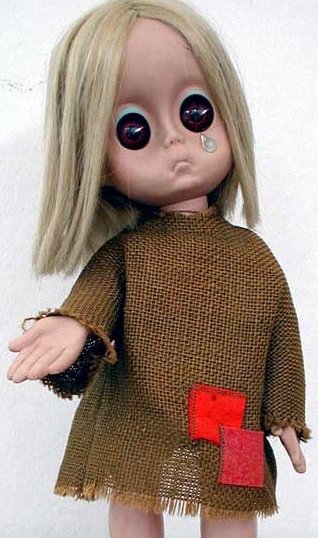
This strange doll was introduced in 1965 by the Hasbro toy company. It was meant to win the hearts of little girls. In order to achieve that, Hasbro took an unconventional approach. Instead of making it sweet and desirable like Barbie, they dressed Miss No Name in rags and made her look like a little beggar girl. With enormous and unblinking eyes and a sad mouth expression, a big plastic tear on her cheek, and an extended arm in a begging position, Little Miss No Name was overall a tragical character. A doll who had nothing.
Instead of asking for love, the doll was made to look like it’s asking for pity. Taking care for a pitiful little doll is not the ideal way for a girl to have fun. It sounds really depressing. Little Miss No Name’s trademark were her big brown eyes. Big compassionate eyes were apparently part of the pop-culture in the 60s, it was a widespread phenomenon. Depictions of frail children or cute little animals with huge eyes, staring plainly at you, were hanged everywhere. The biggest contribution to this kind of style was made by Margaret Keane. Her artwork was the main inspiration for all of those sad eyes across the globe. There is no doubt that Little Miss No Name followed on from this.
Immediately after it hit the stores, Miss No Name had trouble with sales. Instead of embracing her, little girls were running away with tears in their eyes, tears similar to the one of her cheek. After only one year Hasbro decided to stop production. In order to get rid of the remaining pieces, they tried to offer her in a promotion with Borden’s Dutch hot chocolate. It turned out that she doesn’t go well with chocolate either.
2 Baby Secret
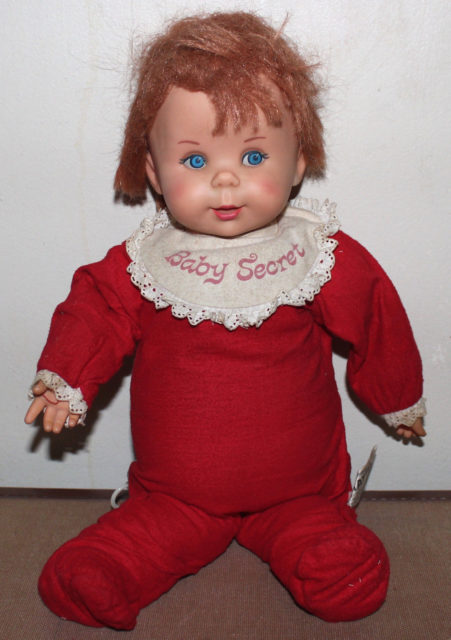
It seems like the 1960’s were a true nightmare for children. If Little Miss No Name wasn’t terrible enough, wait till you hear about the doll that appeared on the market the following year. This demonic doll, called Baby Secret, was produced by the Mattel toy company in 1966. The first thing that pops in mind after seeing it is “Chucky the killer doll”.
The uncanny Baby Secret doll was also known as a “Yacker” because she had the ability to chat with the “lucky” owner. It was centimeters (18 inches) tall, it had a soft baby body and a vinyl head. The manufacturer decided that the best outfit would be a bloody red dress and a white bib, with the words “Baby Secret” embroidered on it. The doll was equipped with an open mouth that moved when it “talked.” Baby Secret’s whisper could be heard when her pull string mechanism was pulled. That whisper was everything but sweet; it was dreadful and eerie as if it came from the underworld. Some of the phrases she whispered were “I want to tell you something” and “I like to sleep with you.” Thеse strange phrases probably caused some weird dreams over the years.
3 Hugo, man of a thousand faces
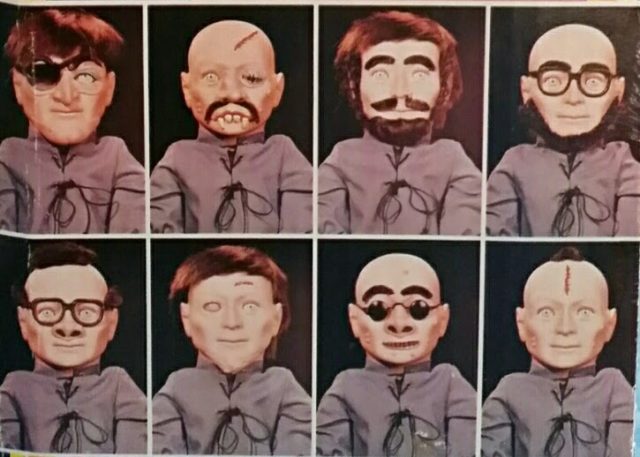
Here is one more in a series of creepy vintage toys. Hugo, the Man of a Thousand Faces is definitely holding a high ranking position in weirdness. In 1975, US toy company Kenner released Hugo, Man of a Thousand Faces. The toy was meant for children 5–11 years old. Sure, just give children the ability to practice disguise and face-altering techniques and everything will be just fine. Hugo was 12-inch tall vinyl mannequin head with no lower body. His arms were stuffed with cotton, and if you pulled a string that was attached to him, you could make his arms move in a funny way. Without the set of facial disguise accessories, he was bald-headed and barefaced, with psychotic eyes focused on the “victim” that plays with him. According to Kenner, there were up to thousand characters that you could make with the pieces of the set.
It is even stranger that they encouraged children to use the disguise pieces (which include hairpieces, false chins and teeth, fake noses, glasses, scars, warts, an eyepatch, a bandage, and more) doesn’t really help) on themselves! They even provided a special glue for this purpose. In another statement, Kenner went further and suggested that Hugo could even serve as a ‘special friend” for your children. “Special friend!”, cmon guys! This is too much weirdness, giving your children an imaginary friend toy isn’t the best way to raise them.
Adding the accessories didn’t improve his looks, they just made him creepier. Ultimately, Hugo could be described as a strange combination of a plastic surgery patient and a terrible Frankenstein-like creature. His whole figure is unsettling. His dead stare is something that can not be avoided – he appears to be sizing you and observing you.
Hugo’s popularity didn’t last much beyond the 1970s, he slowly disappeared from the market.
4 Baby’s First Butcher Shop
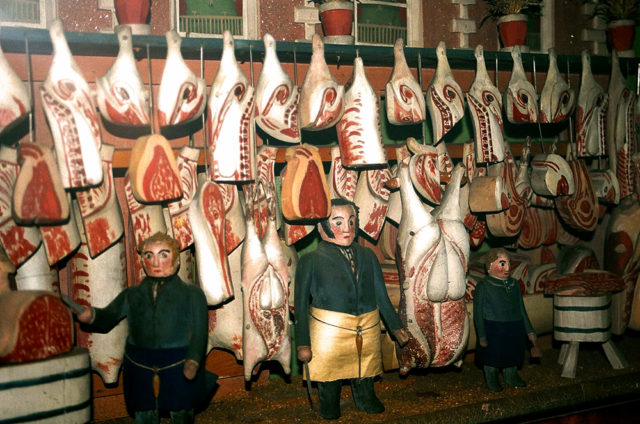
What is better than teaching your kid how to butcher stuff?! Apparently, that was normal for Victorian parents. That is why butcher shop doll houses were quite popular back in 1840. The Babies First Butcher Shop was a detailed scaled model of a butchery. It had all the things a real shop would have: wooden butchers and their assistants and a bunch of sausages, and miniature carcasses hanging all around from iron hooks. To make the whole experience more realistic, they even put sawdust and blood on the tiny floors.
5 Creeping Baby Doll
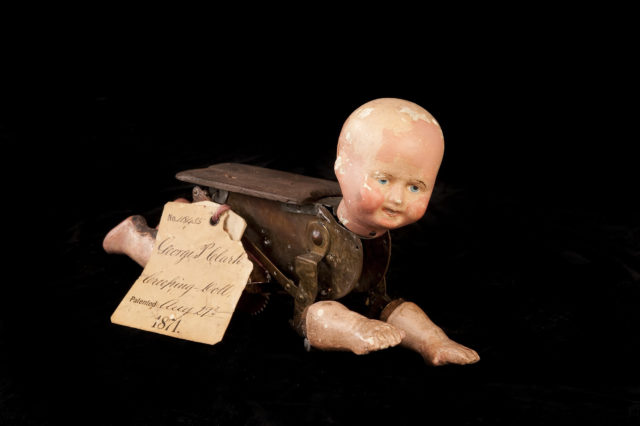
This horrifying, baby-imitating contraption was Patented in 1871 and it was called the “Creeping Baby Doll.” The Victorians surely knew how to make quality horror props! The Creeping Baby automaton was made to imitate a crawling baby, but despite it functioning properly as a machine, it had a few flaws that made it undesirable to children. The device was too heavy and it wasn’t interactive enough besides turning it on, and then run in fear that the mechanical baby could catch you and eat you alive.
In case you were wondering, before the mid-1800s “creeping” was a term that was used instead of “crawling”. It was an activity connected with animals and crazy people.
